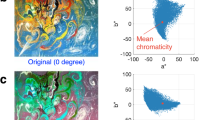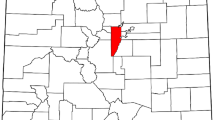Abstract
Paintings are in essence about visual features of varying significance from which differences in their market prices originate. Studies normally investigate derivative sources of painting price determinants, which is reasonably understandable because the appreciation of an image is quite subjective. This paper provides an operational solution to the quantification of paintings based on a new concept termed as “visual autocorrelation” of prices (VAP). Considering the current empirical framework of spatial and temporal autocorrelation of prices, and using data on the paintings of two abstract expressionist artists, empirical results support the coherence of the VAP concept.

Similar content being viewed by others
Notes
The “mental space” concept used here is similar to the one that explains the phenomenon of language (Fauconnier and Turner 2002). It is a theoretical construct where elements of knowledge are connected to each other by various kinds of mappings, in particular identity and analogy mappings. In this view, mental spaces operate in working memory but are built up partly by activating structures available from long-term memory. It is a general property of mental space configurations that identity connections link elements across spaces.
As in the spatial autocorrelation framework, we may suppose that visual dependency can also be incorporated in the error structure (\( E\left\lceil {\varepsilon_{i} \varepsilon_{j} } \right\rceil \ne 0 \)) (Eq. 2). A specification with an autoregressive visual error model can be used to develop more accurate estimates with \( \varepsilon = \lambda W^{\prime } \varepsilon + \xi \). Its estimates indicate that after taking into account the influence of the VAP parameter, there still exist some visual correlations in the residuals (referred to as nuisance dependence) of the model where parameters λ and W′ are significantly different from zero.
We have used a simple weighting scheme for the selection and the weighting of comparables based on the Euclidean similarity distances. A more accurate filtering process could be developed from the use of alternative metrics, like in Mahalanobis (1936).
For a fixed set of data and underlying statistical model, the method of maximum likelihood selects values of the model parameters that produce a distribution which gives the observed data the greatest probability (i.e., parameters that maximize the likelihood function). In the process of selecting the closest 3 comparables to the subject, the filtering execution brought the same number each time. However among them, some of the comparables might not be very similar to the subject. In those cases, the algorithm of selection can use some deeper criteria, as in Vandell (1991). Based on the case of real estate properties, he applies actual statistical theory to decisions about how many comparables to select, what the criteria for comparable selection should be, and how the proper weights for each adjusted value estimate can be determined such that the final value estimate is both unbiased and of minimum variance.
Neither the data that we used nor viewing the digital images provided any information about the physical condition of the paintings. However, depreciation in the physical condition of paintings might have a significant effect on their value.
All the images were projected in front of two specially gathered classes of respectively 30 and 45 students enrolled in the undergraduate program in the Business School. Before the evaluation, they were asked to consider only the five criteria related to the semantic features of images, by making abstraction of the quality of the images. At the end of the class, an average of their evaluation per semantic criterion was taken to construct the VAP parameter.
To control for the interactions among the parameters and to detect the multicolinearity problems, results are generated with the variance inflation factor (VIF). This test provides an indication about the severity of interactions in the model and usually suggests a value less than “5”. The results of the VIF in the models presented are all less than 4 (most of the cases settle around 1).
Similar to the correlation coefficient, Moran’s I varies between –1.0 and +1.0; when autocorrelation is high, the coefficient is high, indicating a significant autocorrelation. Geary’s C is inversely related to Moran’s I and its values typically range between 0 and 2; if the value is zero or closer, it indicates positive spatial autocorrelation.
References
Agnello, R., & Pierce, R. (1996). Financial returns, price determinants and genre effects in American art investment. Journal of Cultural Economics, 20(4), 359–383.
Anderson, R. C. (1974). Paintings as an investment. Economic Inquiry, 12(1), 13–26.
Anselin, L. (1988). Spatial econometrics: Methods and models. Dorddrecht: Kluwer Academic Publishers.
Ashenfelter, O., & Graddy, K. (2003). Auctions and the price of art. Journal of Economic Literature, 41(3), 763–786.
Bailey, M. J., Muth, R. F., & Nourse, H. O. (1963). A regression method for real estate price index construction. Journal of the American Statistical Association, 58, 933–942.
Bauwens, L., & Ginsburgh, V. (2000). Art experts and auctions: Are pre-sale estimates unbiased and fully informative? Recherches Economiques de Louvain/Louvain Economic Review, 66, 131–144.
Caruso, L. (1993). Color. London: Dorling Kindersley.
Chanel, O., Gérard-Varet, L.-A., & Ginsburgh, V. (1996). The relevance of hedonic price indices. The case of paintings. Journal of Cultural Economics, 20(1), 1–24.
Craven, D. L., & Leslie, R. (1981). The automatic paintings of Jean Paul-Riopelle. Artscanada, 240–241.
Czujack, C. (1997). Picasso painting at auction. Journal of Cultural Economics, 21(3), 229–247.
De Rynck, P. (2004). How to read a painting: Lessons from the old masters. New York: Harry N. Abrams.
Ekelund, R. B. Jr., Ressler, R. W., & Watson, J. K. (1998). Estimates, bias and “no sales” in Latin-American art auctions, 1977–1996. Journal of Cultural Economics, 22(1), 33–42.
Fauconnier, G., & Turner, M. (2002). The way we think. New York: Basic Books.
Gage, J. (2001). Color and meaning—art, science and symbolism. London: Thames and Hudson.
Gibler, K. M., & Nelson, S. L. (1998). Consomer behavior applications to Real Estate. Paper presented at the American Real Estate Society Meeting (April 1998), pp. 1–28.
Ginsburgh, V., & Schwed, N. (September 1992) Price trends for old masters’ drawings: 1980–1991. The Art Newspaper.
Ginsburgh, V., Mei, J., & Moses, M. (2006). On the computation of prices indices. Working Paper Series available at http://ideas.repec.org/h/eee/artchp/1-27.html.
Goetzmann, W., Renneboog, L., & Spaenjers, C. (2010) Art and money. NBER Working Paper 15502 available at http://nber.org/papers/w15502.
Goussef, C. (2008) L’exil russe—La fabrique du réfugié apatride. CNRS Editions.
Kulvicki, J. (2010). Knowing with images: Medium and message. Philosophy of Science, 77(2), 295–313.
Lesage, J. P. (1997). Regression analysis of spatial data. The Journal of Regional Analysis & Policy, 27(2), 83–94.
Locatelli Biey, M., & Zanola, R. (1999). Investment in paintings: A short-run price index. Journal of Cultural Economics, 23, 211–222.
Mahalanobis, P. C. (1936). On the generalized distance in statistics. Proceedings of the National Institute of Sciences of India, 2(1), 49–55.
Mills, T. C. (1990). Time series techniques for economists. Cambridge: Cambridge University Press.
Perkiö, J., Tuominen, A., Vähäkangas, H., & Myllymäki, P. (2012). Image similarity: From syntax to weak semantics using multimodal features with application to multimedia retrieval. Multimedia Tools and Applications, 57(1), 5–27.
Pesando, J. E., & Shum, P. M. (2008). The auction market for modern prints: Confirmations, contradictions, and new puzzles. Economic Inquiry, 46, 149–159.
Renneboog, L., & Spaenjers, C. (2011). Buying beauty: On prices and returns in the art market. RePEc Working Paper Series available at http://ideas.repec.org/p/dgr/kubcen/200915.html.
Sagot-Duvauroux, D., Pflieger, S., & Rouget, B. (1992). Factors affecting price on the contemporary art market. In R. Towse & A. Khakee (Eds.), Cultural economics (pp. 91–102). Berlin and Heidelberg: Springer.
Scorcu, A. E., & Zanola, R. (2011). The “Right” price for art collectibles: A quantile hedonic regression investigation of picasso paintings. Journal of Alternative Investments, 14(2), 89–99.
Shamir, L., Macura, T., Orlov, N., Eckley, D. M., & Goldberg, I. G. (2010). Impressionism, expressionism, surrealism: Automated recognition of painters and schools of art. ACM Transactions on Applied Perception, 7(2), 8–17.
Sproule, R., & Valsan, C. (2006). Hedonic models and pre-auction estimates: Abstract art revisited. Economics Bulletin, 26(5), 1–10.
Tobler, W. (1970). A computer movie simulating urban growth in the Detroit region. Economic Geography, 46(2), 234–240.
Tuceryan, M., & Jain, A. K. (1993). Texture analysis, (Chapter 2). Singapore: World Scientific Publishing Co.
Ursprung, H. W., & Wiermann, C. (2008). Reputation, price, and death: an empirical analysis of art price formation. CESIFO Working Paper no. 2237, 31 pages.
Vandell, K. D. (1991). Optimal comparable selection and weighting in real property valuation. AREUEA Journal, 19(2), 213–239.
Wallraven, C., Fleming, R., Cunningham, D. W., Rigau, J., Feixas, M., & Sbert, M. (2008). Categorizing art: Comparing humans and computers. Computers and Graphics, 33(4), 484–495.
Woodford, S. (1991). Looking at pictures. The cambridge introduction to art: Cambridge University Press, Cambridge.
Zanola, R. (2007) The dynamics of art prices: The selection corrected repeat-sales index. Paper presented at The Art Markets Symposium, Maastricht, March 2007.
Zeki, S. (1999). Inner vision: An exploration of art and the brain. Oxford: Oxford University Press.
Author information
Authors and Affiliations
Corresponding author
Rights and permissions
About this article
Cite this article
Özdilek, Ü. Visual autocorrelation of prices. J Cult Econ 37, 203–223 (2013). https://doi.org/10.1007/s10824-012-9178-2
Received:
Accepted:
Published:
Issue Date:
DOI: https://doi.org/10.1007/s10824-012-9178-2




